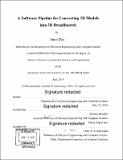| dc.contributor.advisor | Stefanie Mueller. | en_US |
| dc.contributor.author | Zhu, Junyi,S.M.Massachusetts Institute of Technology. | en_US |
| dc.contributor.other | Massachusetts Institute of Technology. Department of Electrical Engineering and Computer Science. | en_US |
| dc.date.accessioned | 2019-11-04T20:21:33Z | |
| dc.date.available | 2019-11-04T20:21:33Z | |
| dc.date.copyright | 2019 | en_US |
| dc.date.issued | 2019 | en_US |
| dc.identifier.uri | https://hdl.handle.net/1721.1/122732 | |
| dc.description | Thesis: S.M. in Computer Science and Engineering, Massachusetts Institute of Technology, Department of Electrical Engineering and Computer Science, 2019 | en_US |
| dc.description | Cataloged from PDF version of thesis. | en_US |
| dc.description | Includes bibliographical references (pages 44-46). | en_US |
| dc.description.abstract | 3D breadboards are a new form of physical prototypes with breadboard functions directly integrated into its surfaces. 3D breadboards offer both the flexibility and re-configurability of breadboards, while also integrating well with the shape of the prototype. As a result, 3D breadboards can be used to test function directly in context of the actual physical form. Our custom 3D editor plugin supports designers in the process of converting 3D models into 3D breadboards. Our plugin first generates a pinhole pattern on the surface of the 3D model; designers can then connect the holes into power lines and terminal strips depending on the desired layout. To fabricate the 3D breadboards, designers only have to 3D print the housing and then fill the wire channels with conductive silicone. We explore a number of computational design and computer graphics approaches to convert arbitrary 3D models into 3D breadboards. We demonstrate a range of different interactive prototypes designed by our software system, and report on a user study with six participants to validate the concept of integrating breadboards into physical prototypes. | en_US |
| dc.description.statementofresponsibility | by Junyi Zhu. | en_US |
| dc.format.extent | 46 pages | en_US |
| dc.language.iso | eng | en_US |
| dc.publisher | Massachusetts Institute of Technology | en_US |
| dc.rights | MIT theses are protected by copyright. They may be viewed, downloaded, or printed from this source but further reproduction or distribution in any format is prohibited without written permission. | en_US |
| dc.rights.uri | http://dspace.mit.edu/handle/1721.1/7582 | en_US |
| dc.subject | Electrical Engineering and Computer Science. | en_US |
| dc.title | A software pipeline for converting 3D models into 3D breadboards | en_US |
| dc.title.alternative | Software pipeline for converting three-dimensional models into three-dimensional breadboards | en_US |
| dc.type | Thesis | en_US |
| dc.description.degree | S.M. in Computer Science and Engineering | en_US |
| dc.contributor.department | Massachusetts Institute of Technology. Department of Electrical Engineering and Computer Science | en_US |
| dc.identifier.oclc | 1124679434 | en_US |
| dc.description.collection | S.M.inComputerScienceandEngineering Massachusetts Institute of Technology, Department of Electrical Engineering and Computer Science | en_US |
| dspace.imported | 2019-11-04T20:21:32Z | en_US |
| mit.thesis.degree | Master | en_US |
| mit.thesis.department | EECS | en_US |
